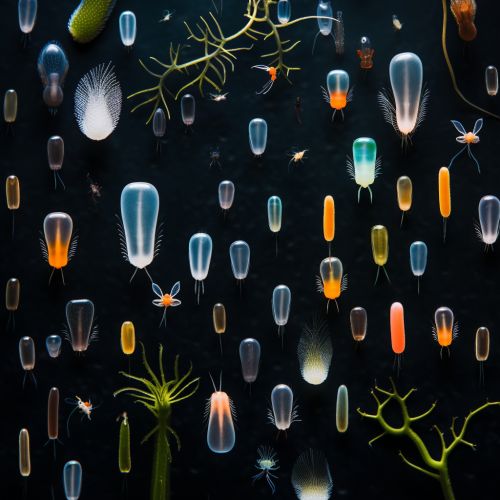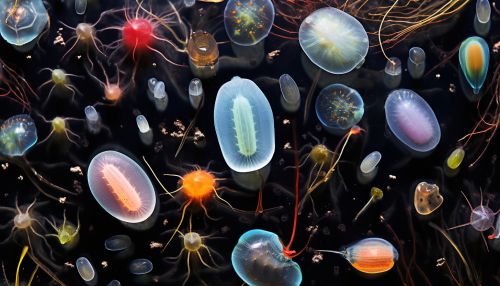Microplankton
Overview
Microplankton, also known as netplankton, are a diverse group of microscopic organisms that float in the world's oceans, seas, and bodies of fresh water. These organisms, which include protists, bacteria, and archaea, typically range in size from 20 to 200 micrometers. They play a crucial role in the marine food web, serving as a primary source of food for larger organisms, including zooplankton, fish, and whales.


Classification
Microplankton are classified into various groups based on their characteristics and functions. The main categories include phytoplankton, zooplankton, and bacterioplankton.
Phytoplankton
Phytoplankton are photosynthetic microorganisms that form the base of the marine food web. They include various species of diatoms, dinoflagellates, and cyanobacteria. These organisms convert sunlight into chemical energy through the process of photosynthesis, producing oxygen as a byproduct.
Zooplankton
Zooplankton are heterotrophic planktonic animals that feed on other plankton, including phytoplankton and smaller zooplankton. They include various species of copepods, krill, and jellyfish. Zooplankton serve as a crucial link between the primary producers (phytoplankton) and the higher trophic levels in the marine food web.
Bacterioplankton
Bacterioplankton are bacteria and archaea that play a crucial role in nutrient cycling in aquatic ecosystems. They are involved in various processes, including the decomposition of organic matter, nitrogen cycling, and carbon cycling.
Ecological Role
Microplankton play a vital role in the functioning of aquatic ecosystems. They contribute to primary production, nutrient cycling, and the marine food web.
Primary Production
Phytoplankton, a subset of microplankton, are the primary producers in aquatic ecosystems. They convert sunlight into chemical energy through photosynthesis, providing a vital source of food for other organisms. The productivity of phytoplankton is a key determinant of the overall productivity of an aquatic ecosystem.
Nutrient Cycling
Microplankton, particularly bacterioplankton, play a crucial role in nutrient cycling. They decompose organic matter, releasing nutrients back into the water. They also participate in various biogeochemical cycles, including the nitrogen and carbon cycles.
Marine Food Web
Microplankton form the base of the marine food web. Phytoplankton serve as a primary source of food for zooplankton, which in turn are consumed by larger organisms, including fish and whales. The abundance and diversity of microplankton can significantly influence the structure and dynamics of the marine food web.
Research and Monitoring
Microplankton are often used as indicators of water quality and ecosystem health. Changes in their abundance, diversity, or composition can signal shifts in environmental conditions or the impacts of human activities. Monitoring programs typically involve regular sampling and identification of microplankton species, along with measurements of physical and chemical parameters.
